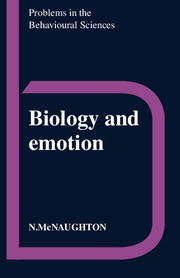Book contents
- Frontmatter
- Contents
- Preface
- Acknowledgements
- 1 Emotion since Darwin
- 2 Releasers and state-dependent reflexes
- 3 Purpose and emotion
- 4 Expression: a window on the emotions?
- 5 Are physiological changes epiphenomena of emotion?
- 6 Somatic influences on the emotions
- 7 Optimal foraging and the partial reinforcement effect: a model for the teleonomy of feelings?
- 8 Do emotions mature or differentiate?
- 9 Cognition, learning and emotion
- 10 Interaction of the components of emotion
- 11 Of mice and men
- 12 Biology and emotion: some conclusions
- Glossary
- Notes
- References
- Index
5 - Are physiological changes epiphenomena of emotion?
Published online by Cambridge University Press: 05 August 2012
- Frontmatter
- Contents
- Preface
- Acknowledgements
- 1 Emotion since Darwin
- 2 Releasers and state-dependent reflexes
- 3 Purpose and emotion
- 4 Expression: a window on the emotions?
- 5 Are physiological changes epiphenomena of emotion?
- 6 Somatic influences on the emotions
- 7 Optimal foraging and the partial reinforcement effect: a model for the teleonomy of feelings?
- 8 Do emotions mature or differentiate?
- 9 Cognition, learning and emotion
- 10 Interaction of the components of emotion
- 11 Of mice and men
- 12 Biology and emotion: some conclusions
- Glossary
- Notes
- References
- Index
Summary
There are many lies in the world, and not a few liars, but there are no liars like our bodies, except it be the sensations of our bodies
Rudyard Kipling: KimWhy do physiological changes accompany emotion?
The work of Cannon discussed in Chapter 1 centred on pain and fear as ‘great emotions’. It is also now obvious that ‘in the natural state and particularly in subhuman species, the aggression, attachment and sexual patterns are usually accompanied by autonomic discharge …. The same functional stimuli activate the behaviour pattern and the autonomic nervous system arousal’ (Mandler, 1975, p.136). Cannon suggested, essentially, that most such changes can be viewed as physiological preparations for the situation facing the animal. Even with the broader selection of emotions presented by Mandler, this view is unlikely to be contentious in either mechanistic or teleonomic terms.
Let us consider mechanism first. Particularly with examples like the let-down reflex or salivation (Section 2.4) to guide us we can accept that certain stimuli or the interpretation of those stimuli could result in activity in either the autonomic nervous system or glands under nervous control. The release of compounds such as adrenaline or direct action of the autonomic nervous system can then produce extensive changes in the animal's physiology which can involve increased muscular power, decreased bleeding, etc.
- Type
- Chapter
- Information
- Biology and Emotion , pp. 51 - 66Publisher: Cambridge University PressPrint publication year: 1989

